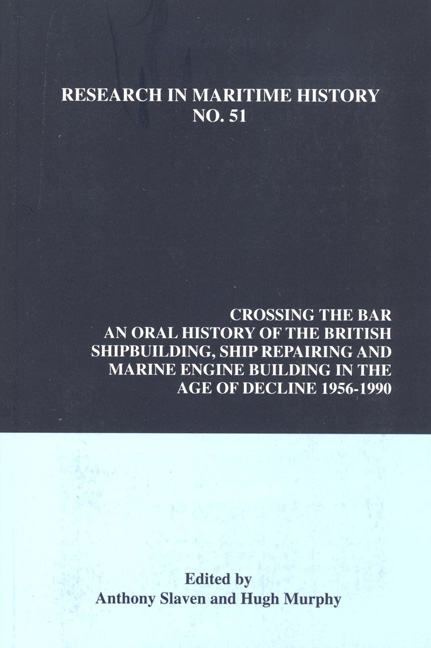 Crossing the Bar
Crossing the Bar from Lower Clyde
I joined Scott's, which was an independent private company, in 1935, as an office boy, and served two years. At the age of sixteen years and three months I started an apprenticeship as a fitter. In parallel with that, I also attended evening classes. After two years and ten months of my apprenticeship in various departments, I was asked to go to the Drawing Office as a result of attaining a certain standard in evening classes. In August 1940, I became a trainee Draughtsman. In May 1941, during the Blitz, the whole place [the Drawing Office and Company Office] was burnt down. Fortunately the entire daily workload was transferred to concrete safes on a daily basis, and we were able to carry on. By 1948, I was an Assistant Engineering Estimator, and by 1950, a Personal Assistant to the Managing Director. In 1953, I was appointed Assistant Chief Draughtsman, and in 1955, Chief Draughtsman (Engineering). In 1960 I moved into line management as Engineering Manager of Scott's, and in 1966, became Engineering Director, and continued in that capacity post the Scott Lithgow merger in 1970.
I think that the major strength of Scott's was that it was a private company. The major shareholder was John Swire and Sons of London who owned the airline Cathay Pacific [and the Taikoo Dockyard in Hong Kong] amongst many other things. They tended to retain a very distinct influence on what the company did, and they certainly watched the financial side of the business. The second strength we had was our reputation for building highclass products, particularly submarines. The company was technically strong, and the drawing offices were particularly good. We were not that large, and I am not sure whether that was a strength or a weakness. The Scott part of Scott Lithgow never got above 3500 people. You have to understand that a great influence on all that went on in Greenock in the years from 1960 onwards was the navy. People like Yarrows and Vickers (Barrow) who always gave jobs to retired naval officers, seemed to have a far better image of the navy than we had. I felt this was a great shame because we did not deserve to be in that position. We were not strong in dealing with the navy and that was a weakness.
To save this book to your Kindle, first ensure [email protected] is added to your Approved Personal Document E-mail List under your Personal Document Settings on the Manage Your Content and Devices page of your Amazon account. Then enter the ‘name’ part of your Kindle email address below. Find out more about saving to your Kindle.
Note you can select to save to either the @free.kindle.com or @kindle.com variations. ‘@free.kindle.com’ emails are free but can only be saved to your device when it is connected to wi-fi. ‘@kindle.com’ emails can be delivered even when you are not connected to wi-fi, but note that service fees apply.
Find out more about the Kindle Personal Document Service.
To save content items to your account, please confirm that you agree to abide by our usage policies. If this is the first time you use this feature, you will be asked to authorise Cambridge Core to connect with your account. Find out more about saving content to Dropbox.
To save content items to your account, please confirm that you agree to abide by our usage policies. If this is the first time you use this feature, you will be asked to authorise Cambridge Core to connect with your account. Find out more about saving content to Google Drive.